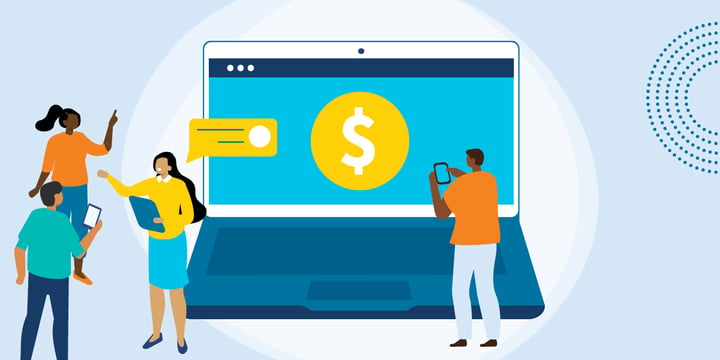In order to build a successful communication and fundraising ecosystem, you need to have the right contact management solution. When weighing up your options, a major decision you need to make is whether to choose a constituent relationship manager (CRM) or donor management system (DMS). Let's get an overview of what both systems do, the key differences, and how to decide which is best for your organization.

What's a CRM?
A constituent or customer relationship manager (CRM), is a database that streamlines your communication, fundraising, and constituent service efforts. It tracks every interaction you and your team have with each individual contact, helping you to follow the history of their relationship with your organization. Nonprofits use CRMs to track sponsorship efforts, build relationships, and analyze audience behavior to improve engagement and retention.
What's a DMS?
A donor management system (DMS) is essentially a donation-specific CRM. It's a tool that helps nonprofit or charity organizations manage their relationships with donors, including donor data, past donation records, and communications. A DMS is typically used by fundraising and development teams to track contributions, manage communications, and analyze donor behavior to improve fundraising efforts.
Similarities and Differences
While there are some differences between CRM and DMS systems, they share a common goal of improving customer or donor relationships and engagement through effective data management, collaboration, and analytics.
Let's first look at the similarities between the two tools.
- Relationship Management: Both CRM and DMS systems are designed to help manage and maintain relationships with customers or donors. They enable organizations to track interactions, store information, and analyze data to improve engagement and retention.
- Data Management: Both systems involve the management of large amounts of data, such as customer or donor contact information, transaction histories, and engagement records. Both typically provide tools to help keep this data organized and up to date.
- Collaboration: Both systems can help improve collaboration within teams, by enabling team members to share information and work together more effectively. For example, a communications team can use a CRM to collaborate on marketing efforts like email marketing, while a fundraising team can use a DMS to collaborate on donor communications.
- Reporting and Analytics: Both systems typically provide reporting and analytics capabilities, allowing organizations to analyze customer or donor behavior and track the effectiveness of their engagement efforts. This can help organizations make more informed decisions and improve their overall performance.
- Integration: Both systems can be integrated with other tools and platforms, such as email marketing software, social media platforms, and accounting software. This can help organizations streamline their workflows and improve their overall efficiency.
Now let's look at the differences between the two tools.
- Focus: A CRM is primarily focused on managing customer relationships and improving marketing efforts, while a DMS is focused on managing donor relationships and improving fundraising and development efforts.
- Data Types: A CRM primarily manages customer data related to sales and marketing activities, such as lead generation, sales activities, and customer service interactions. A DMS, on the other hand, primarily manages donor data related to fundraising activities, such as donation records, pledge tracking, and grant management.
- Fundraising Features: A DMS typically includes fundraising-specific features that are not found in a CRM, such as online donation processing, pledge tracking, and grant management. A CRM may include features such as sales forecasting, sales automation, and lead scoring that are not typically found in a DMS.
- Communication Channels: A CRM may include features to manage communication channels, such as phone, email, and social media, while a DMS may include features to manage communication channels such as direct mail, email newsletters, and fundraising events.
- Reporting and Analytics: The reporting and analytics capabilities of a CRM may be more focused on sales and marketing metrics, such as lead conversion rates and customer acquisition costs. In contrast, the reporting and analytics capabilities of a DMS may be more focused on fundraising metrics, such as donor retention rates and fundraising ROI.
- Pricing: While pricing can vary widely depending on the specific system and provider, in general, CRM systems tend to be more expensive than DMS systems. This is partly due to the additional functionality and customization options that are typically available in a CRM.
Which Tool Is Best for My Organization?
Overall, the two tools have different priorities, data types, and features, and choosing which one is best for your organization really comes down to what you need to get out of it. While a DMS is a great tool for nonprofits to use for fundraising efforts, these are the only efforts it will cover. If you do choose to use a DMS, you'll need an alternative system to cover other marketing goals or initiatives. A CRM on the other hand, is going to cover a wider range of initiatives, but it may not have as many fundraising-specific functions as a DMS.
If your nonprofit's main goal is fundraising and you have decided to implement a DMS, one option you might consider is Little Green Light. Here are a few features offered within the tool.
- Ease of Use: Little Green Light is known for its user-friendly interface, which can make it easy for nonprofits to get up and running quickly. The system also includes a range of support resources, including online training courses and a dedicated support team.
- Customization: Little Green Light is highly customizable, which means nonprofits can tailor the system to their unique needs. This can include customizing donation pages, creating custom reports, and integrating with other tools and platforms.
- Integration: Little Green Light integrates with a range of other tools and platforms, including online fundraising platforms, email marketing software, and accounting software. This can help nonprofits streamline their workflows and reduce the amount of manual data entry required.
- Security: Little Green Light takes security seriously, with features such as two-factor authentication and data encryption to help protect sensitive donor information.
- Pricing: Little Green Light is priced competitively, with a range of pricing plans to suit nonprofits of different sizes and needs. This can make it an affordable option for organizations with limited budgets.
If your nonprofit's goals are broader and could benefit from having a CRM, HubSpot is a tool you might consider. Discover some of the features it offers below.
- Cost: HubSpot CRM is free to start, which can be an advantage for nonprofits that may have limited budgets for technology solutions. Adding HubSpot Marketing, CMS, or Sales Hub will come at a price, but you can add different facets as your organization and goals grow.
- Customization: The HubSpot CRM is highly customizable, which means nonprofits can tailor the system to their unique needs. This can be particularly useful for organizations with complex fundraising or donor management needs.
- Integration: HubSpot integrates with a wide range of other tools and platforms, including social media, email marketing, and fundraising platforms. This can help nonprofits streamline their workflows and reduce the amount of manual data entry required.
- Automation: The CRM includes a range of automation features, such as lead scoring and workflow automation, which can help nonprofits improve their efficiency and productivity.
- Reporting: HubSpot includes robust reporting and analytics features, which can help nonprofits track their fundraising and donor management efforts and make data-driven decisions.
- Support: HubSpot provides a range of resources and support options to help nonprofits get the most out of their CRM, including a community forum, online training courses, and a dedicated support team.
Making an Informed Decision
Ultimately, both DMSs and CRMs have their respective places in the nonprofit world, and both bring value to organizations that use them. A DMS is the perfect tool for charitable organizations or nonprofits that are focused solely on fundraising, while a CRM is the one-stop shop for all things marketing.
Still not sure what system is right for your organization? TechSoup Digital Marketing Services experts are here to help. Fill out the inquiry form on our services page for more resources and support in identifying, implementing, and managing your CRM or DMS system.
Additional Resources
- Enroll in TechSoup Courses' Fundraising Software Seminar Series.
- Watch the webinar HubSpot: How to Harness Your CRM for Effective Communication.
- Read about 3 Tools for Donor Management: Decide Which Is Best for Your Organization.
- Explore Budgeting for CRM: 4 Steps to Finding the Right System for Your Nonprofit.
Top photo: Shutterstock








